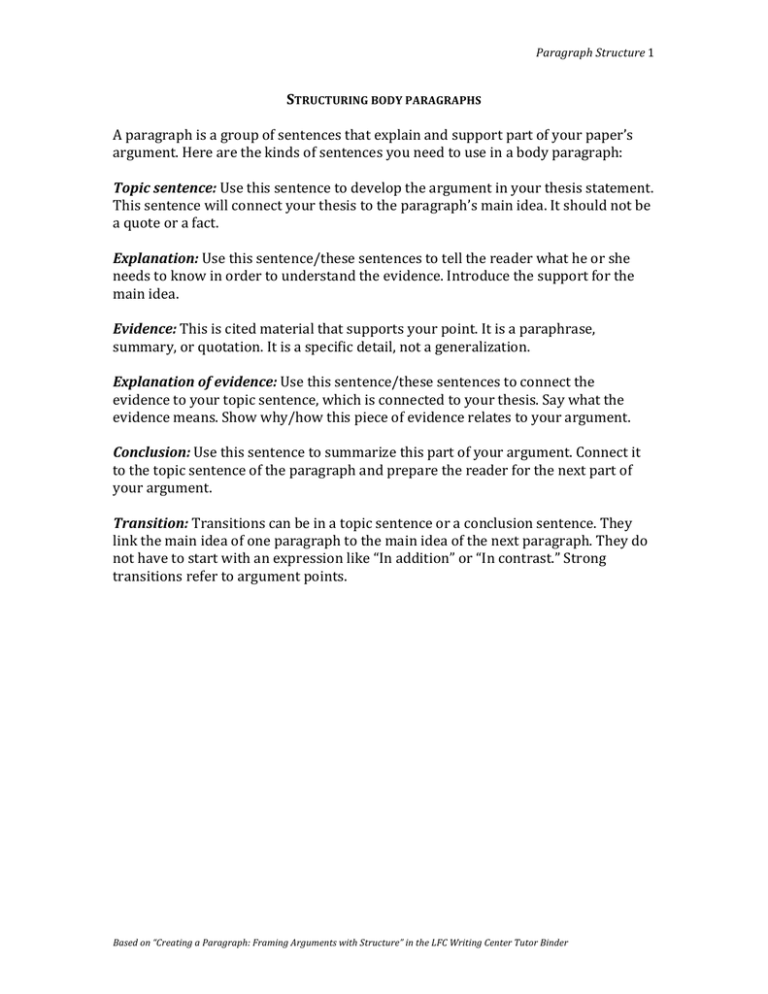A paragraph is a group of sentences that explain and support part of
advertisement

Paragraph Structure 1 STRUCTURING BODY PARAGRAPHS A paragraph is a group of sentences that explain and support part of your paper’s argument. Here are the kinds of sentences you need to use in a body paragraph: Topic sentence: Use this sentence to develop the argument in your thesis statement. This sentence will connect your thesis to the paragraph’s main idea. It should not be a quote or a fact. Explanation: Use this sentence/these sentences to tell the reader what he or she needs to know in order to understand the evidence. Introduce the support for the main idea. Evidence: This is cited material that supports your point. It is a paraphrase, summary, or quotation. It is a specific detail, not a generalization. Explanation of evidence: Use this sentence/these sentences to connect the evidence to your topic sentence, which is connected to your thesis. Say what the evidence means. Show why/how this piece of evidence relates to your argument. Conclusion: Use this sentence to summarize this part of your argument. Connect it to the topic sentence of the paragraph and prepare the reader for the next part of your argument. Transition: Transitions can be in a topic sentence or a conclusion sentence. They link the main idea of one paragraph to the main idea of the next paragraph. They do not have to start with an expression like “In addition” or “In contrast.” Strong transitions refer to argument points. Based on “Creating a Paragraph: Framing Arguments with Structure” in the LFC Writing Center Tutor Binder Paragraph Structure 2 Example Body Paragraph: In this speech, Garrison also invokes an authoritative and righteous persona, which he accomplishes through his use of an exciting, almost biblical tone. Campbell and Burkholder describe persona and tone as, “a role or roles that a rhetor takes on for strategic purposes, much as an actor assumes a role or character in a play” (Campbell/Burkholder 21) and, “those elements of discourse, primarily language elements, that suggest the rhetor’s attitude toward the audiences and the subject matter” respectively (Campbell/Burkholder 23). Garrison does not address his audience as a fellow man, using conversational language and simple terms of expression; rather, he speaks as if he is preaching to a congregation, with the authority one would use to deliver the word of God: “The slaveholder with his hands dripping in blood-­‐-­‐will I make a compact with him? The man who plunders cradles-­‐-­‐will I say to him, ‘Brother, let us walk together in unity?’” (Garrison). Garrison speaks of the slaveholder as if he were a character in a parable, referring to him not as a real person but a dramatic symbol. He compels his listener with the vivid imagery of blood dripping and cradle-­‐robbing and asks a question with an obvious answer as a way of demonstrating the absolute inescapability of his core premise. The authority and perceived righteousness of the persona here invoked is due in large part to the tone that is employed. Garrison does not speak of the slaveholders as people but rather as monsters. He uses metaphor to produce intense imagery that causes the listener or reader to associate Garrison’s enemy with ghastly and totally indefensible concepts, thus making it more likely that we will agree to make him our enemy as well. This collaborative relationship between his preacher-­‐like persona and his heightened, almost poetic tone is visible throughout the speech, all the way through to the end, which is a verse that Garrison has composed for the occasion. Based on “Creating a Paragraph: Framing Arguments with Structure” in the LFC Writing Center Tutor Binder Paragraph Structure 3 HOW TO OUTLINE A BODY PARAGRAPH To help your readers follow your argument, make sure each body paragraph explains one argument point. Write concise paragraphs that thoroughly relate one piece of evidence to one argument point. When you have many ideas, several pieces of evidence, and a working thesis statement, focusing on one idea at a time can be difficult. Try using a short, specific outline to help you. Remind yourself what each sentence should do (Function) and what each sentence should say (Idea). Here is an example: FUNCTION: WHAT EACH SENTENCE DOES 1. Transition to first example after thesis 2. Explain context of upcoming quote 3. Signal phrase for cited evidence 4. Explain how the quote shows #1 5. Conclude/sum up/transition IDEA: WHAT YOU WANT TO SAY Conforming hurts people Parents who role-­‐play hurt children Quote about father-­‐son fight (p. 119) Son frustrated by dad conforming: hurts dad People who are hurt continue cycle Sentences 2, 3, and 4 will always have the above functions. Sentences 1 and 5 will have different functions depending on the kind of paper you are writing and the order of your argument points. For example, you may need functions like: • Transition to second, third, last, etc. example • Transition to counter argument • Transition to conclusion paragraph • Prepare readers for this paragraph and the next two • Summarize last two paragraphs • Summarize Methods, Results, etc. section You can make the functions as specific as you want—just remember that you always need to address 2, 3, and 4 in some way. Example paragraph based on above outline: The character Stephen, a father and well-­‐known minister, illustrates how the pressure of pretending to be a perfect person harms people. Stephen denies stealing money from the community and implicates his son’s friend. His son confronts him by punching Stephen in the face and shouting, “Your life is the lie, not just this crime” (119). The son has been deeply hurt by Stephen’s choice to continue pretending to be perfect rather than tell the truth. He is frustrated to the point of violence and reflects the emotional injury by physically harming his father. Based on “Creating a Paragraph: Framing Arguments with Structure” in the LFC Writing Center Tutor Binder

